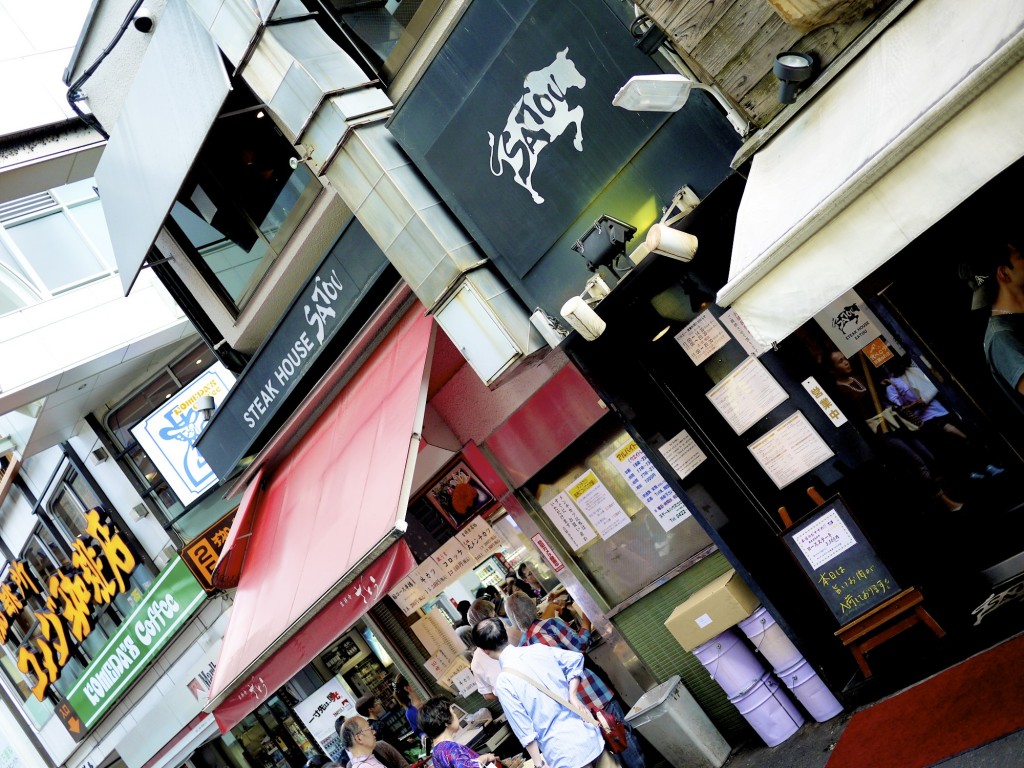 Website: www.shop-satou.com Cuisine: Matsusaka Beef
Website: www.shop-satou.com Cuisine: Matsusaka Beef
For the true aficionados there’s no denying that Japan is the holy grail when it comes to the best quality beef in the world. Whilst premium quality beef in Japan may be better value than having it overseas (and certainly is often fresher), it is still an expensive affair, usually beyond the reach of the average person including myself. That is why Steakhouse Satou in Kichijoji should be on any beef loving carnivores itinerary. Whilst they primarily operate as a butcher through a number of other branches, the Kichijoji arm in Tokyo also has a restaurant on the on the second floor above the ground floor butcher. When we arrived there was a 50 people solid queue. Luckily they were locals, queuing up for the butcher. A good sign none the less.
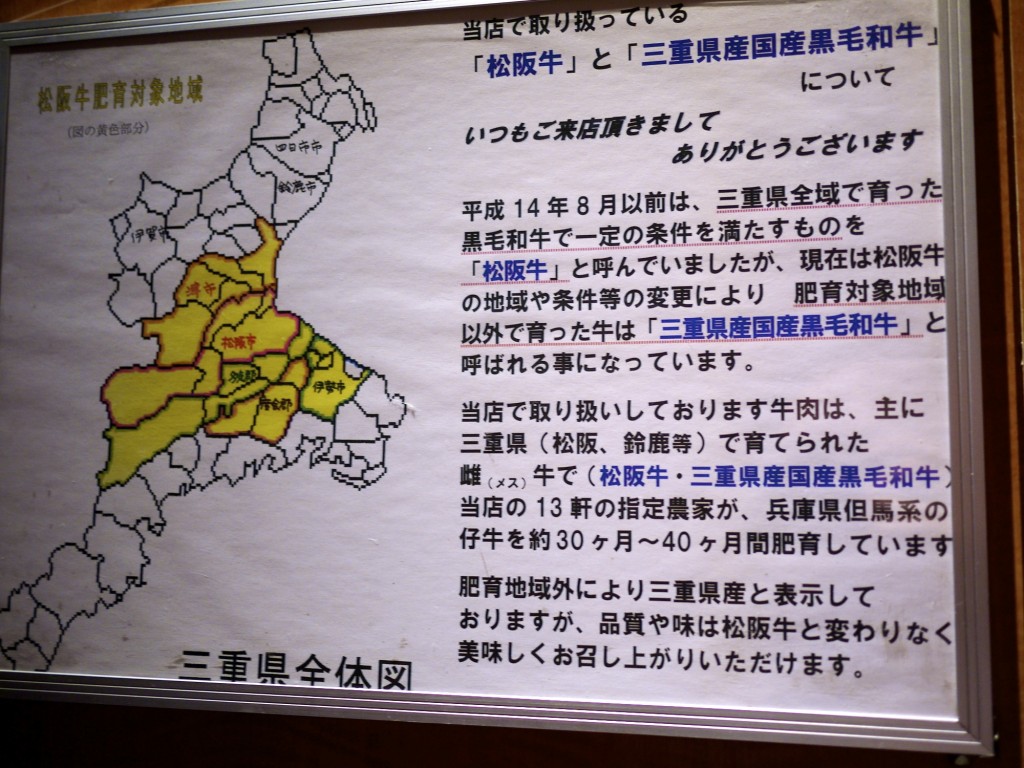 What makes Satou attractive is their affordable price. There is a slight catch, but they are very transparent about it. Prior to August 2002 there were very strict criteria around the catchment area in the Mie prefecture that permitted the use of the name “Matsusaka beef” (otherwise known as Kurogewagyuu or black haired wagyuu – 黒毛和牛). Naturally, as with anything exclusive, that meant a hefty price tag. However post 2002 the catchment area expanded to include surrounding regions now commonly known as the “triple prefecture of black haired wagyuu” (三重県産国産黒毛和牛). That being said, the beef originating from the original exclusive catchment area continues to be considered superior and this is reflected in the price. You’ve probably guessed the catch by now. Satou sources their beef from the new catchment area, although they claim their quality is not inferior to the “real deal”. They focus instead on female breeds between the age of 30 to 40 months.
What makes Satou attractive is their affordable price. There is a slight catch, but they are very transparent about it. Prior to August 2002 there were very strict criteria around the catchment area in the Mie prefecture that permitted the use of the name “Matsusaka beef” (otherwise known as Kurogewagyuu or black haired wagyuu – 黒毛和牛). Naturally, as with anything exclusive, that meant a hefty price tag. However post 2002 the catchment area expanded to include surrounding regions now commonly known as the “triple prefecture of black haired wagyuu” (三重県産国産黒毛和牛). That being said, the beef originating from the original exclusive catchment area continues to be considered superior and this is reflected in the price. You’ve probably guessed the catch by now. Satou sources their beef from the new catchment area, although they claim their quality is not inferior to the “real deal”. They focus instead on female breeds between the age of 30 to 40 months.
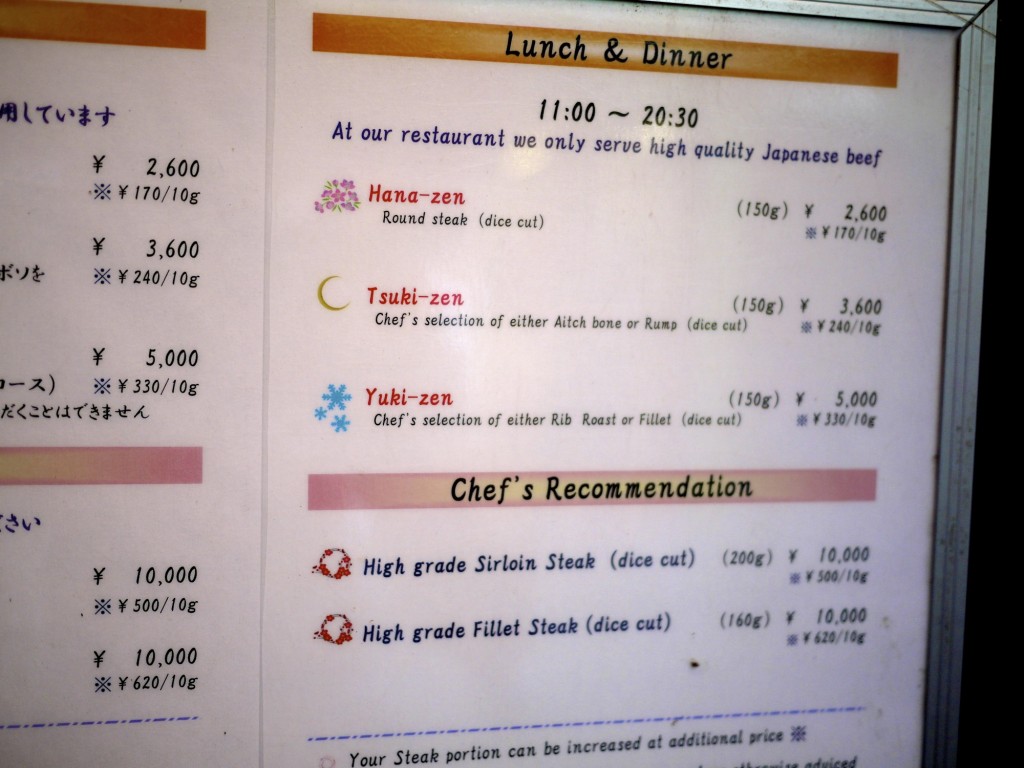 As with any steakhouse there was a choice of different cuts that dictated the price. As we had purposely come to Kichijoji for the best quality we could afford, we decided to opt for the more expensive dinner menu option (which is also available at lunch after popular demand from diners) and get their regular fillet steak (150g) for 5,000 yen and their high grade fillet sirloin steak (200g) for 10,000 yen. We thought it would be interesting to compare the quality of the cuts.
As with any steakhouse there was a choice of different cuts that dictated the price. As we had purposely come to Kichijoji for the best quality we could afford, we decided to opt for the more expensive dinner menu option (which is also available at lunch after popular demand from diners) and get their regular fillet steak (150g) for 5,000 yen and their high grade fillet sirloin steak (200g) for 10,000 yen. We thought it would be interesting to compare the quality of the cuts.
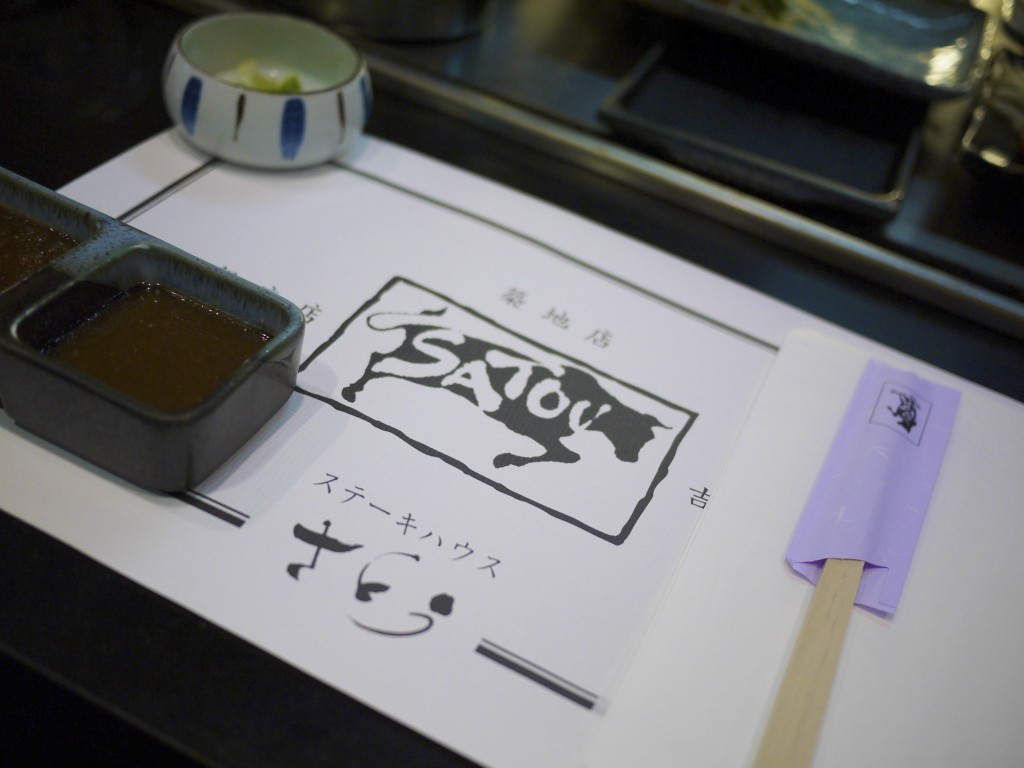 The restaurant itself was tiny and could only seat about 25 diners at any time including six seats at the counter (and you don’t really get a choice of the seat unless you are the first in line). A word of warning though, as the place gets packed very quickly, if you’re not early (preferably ahead of their opening hour), you may end up standing in their ridiculously steep and narrow stairway for half an hour as butchers run up and down bringing the cuts of meat to the restaurant.
The restaurant itself was tiny and could only seat about 25 diners at any time including six seats at the counter (and you don’t really get a choice of the seat unless you are the first in line). A word of warning though, as the place gets packed very quickly, if you’re not early (preferably ahead of their opening hour), you may end up standing in their ridiculously steep and narrow stairway for half an hour as butchers run up and down bringing the cuts of meat to the restaurant.
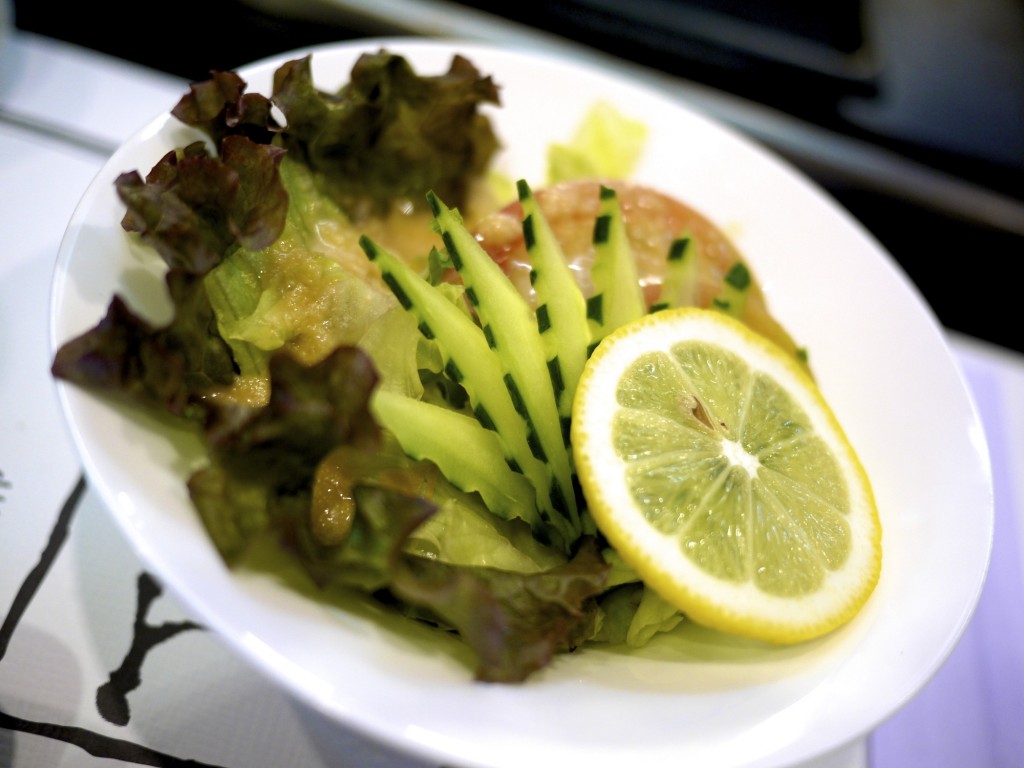 We had some salad to get things going but there was nothing special about it.
We had some salad to get things going but there was nothing special about it.
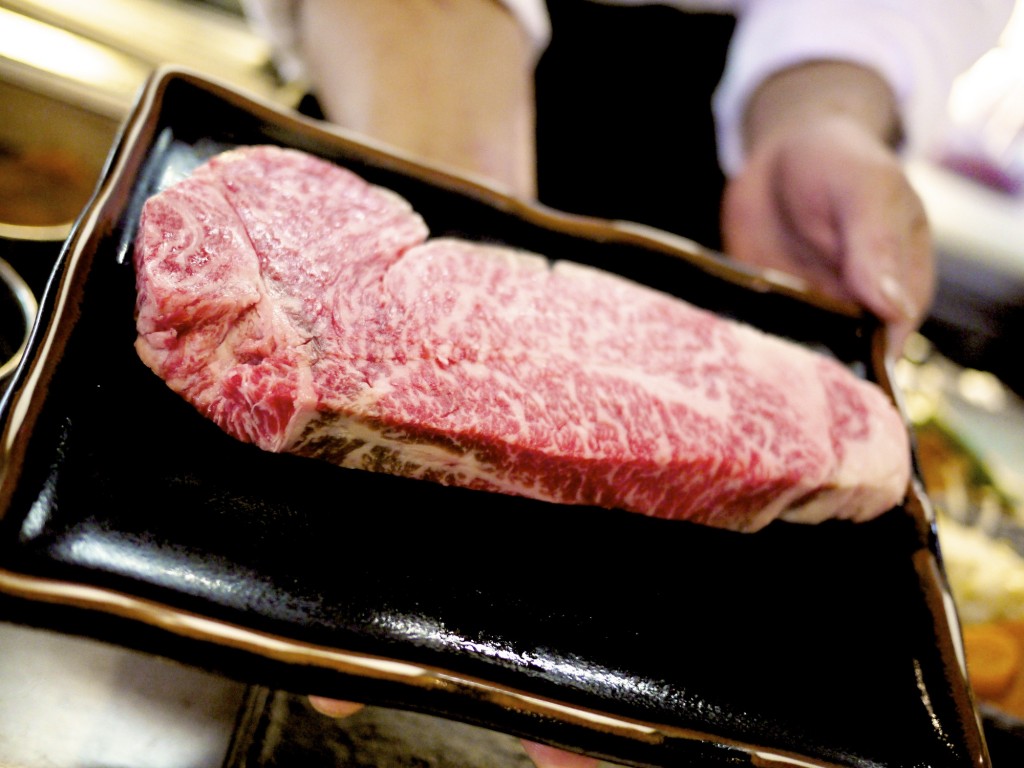 As we had ordered their most expensive cut, the chef behind the counter came to present us the beautifully marbled high grade sirloin steak. It looked absolutely magnificent but I was did wonder whether this was going to be too fatty? As they say, the proof is in the
As we had ordered their most expensive cut, the chef behind the counter came to present us the beautifully marbled high grade sirloin steak. It looked absolutely magnificent but I was did wonder whether this was going to be too fatty? As they say, the proof is in the pudding eating…
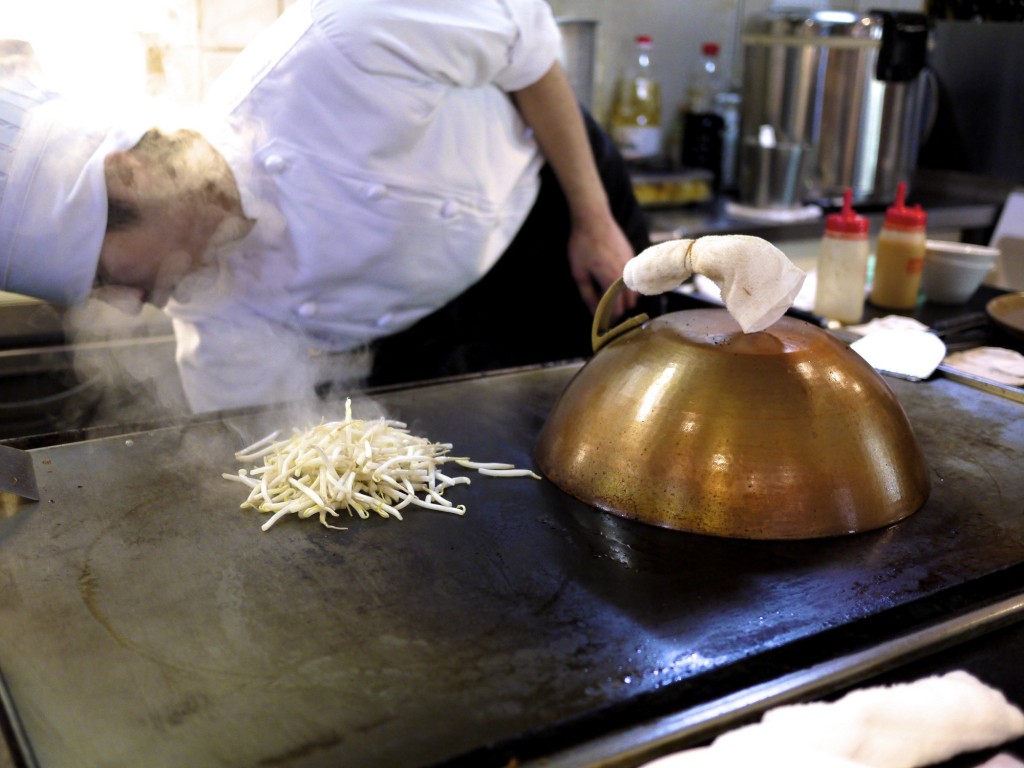 The chef began cooking some beansprouts to go as garnish for our steak. Under the brassy lid to the side were our steaks…
The chef began cooking some beansprouts to go as garnish for our steak. Under the brassy lid to the side were our steaks…
 The chef wasted little time chopping up our fillet first. The olfactory senses were in overdrive!
The chef wasted little time chopping up our fillet first. The olfactory senses were in overdrive!
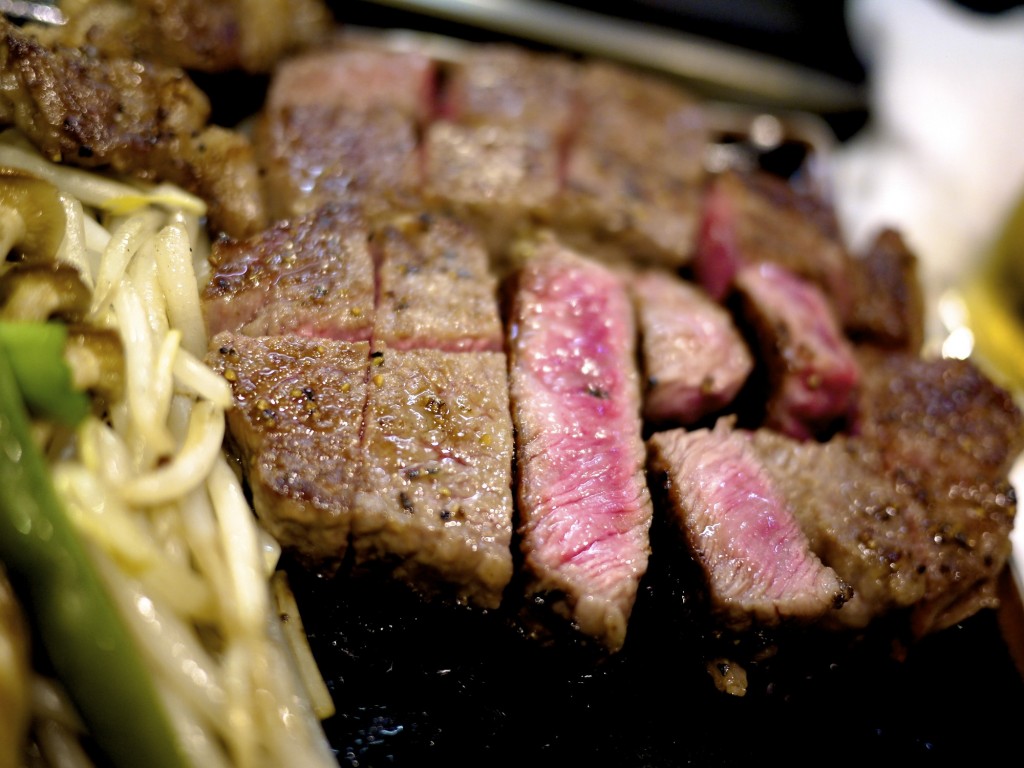 I was genuinely amazed with the quality of the cheaper 5,000 yen fillet steak. The cooking was spot on and served medium-rare, just the way I like it. The balance of the intramuscular fat to the lean meat was just right, making this steak not overly fatty but mouthwatering juicy.
I was genuinely amazed with the quality of the cheaper 5,000 yen fillet steak. The cooking was spot on and served medium-rare, just the way I like it. The balance of the intramuscular fat to the lean meat was just right, making this steak not overly fatty but mouthwatering juicy.
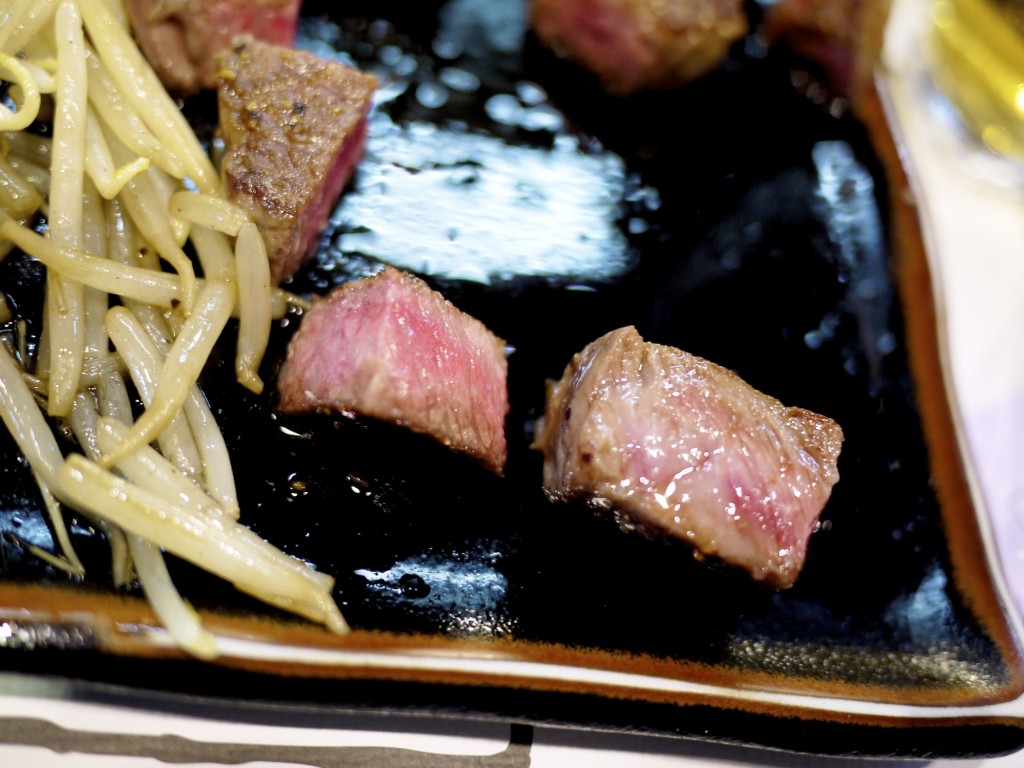 In comparison, you can see the marbling on the right from the high grade 10,000 sirloin steak which had a far higher intramuscular fat content. I enjoyed the first two bites but I must confess that overall I found it rather too oily and fatty. The texture in fact for me was less pleasant due to the high fat content. This is probably considered blasphemy in Japan, but my dining companion Fine Dining Explorer agreed wholeheartedly. We focused on enjoying the fillet steak before we slowly worked our way through the high grade sirloin; after all we couldn’t let it go to waste. It could simply be a matter of taste so don’t take my word as the gospel. I’d honestly advise you to try them side by side. Who knows? You may disagree. Either way, you are in for a treat!
In comparison, you can see the marbling on the right from the high grade 10,000 sirloin steak which had a far higher intramuscular fat content. I enjoyed the first two bites but I must confess that overall I found it rather too oily and fatty. The texture in fact for me was less pleasant due to the high fat content. This is probably considered blasphemy in Japan, but my dining companion Fine Dining Explorer agreed wholeheartedly. We focused on enjoying the fillet steak before we slowly worked our way through the high grade sirloin; after all we couldn’t let it go to waste. It could simply be a matter of taste so don’t take my word as the gospel. I’d honestly advise you to try them side by side. Who knows? You may disagree. Either way, you are in for a treat!

Pingback: Satou, an Amazing “Hidden” Steakhouse in Tokyo – Jason’s Travels